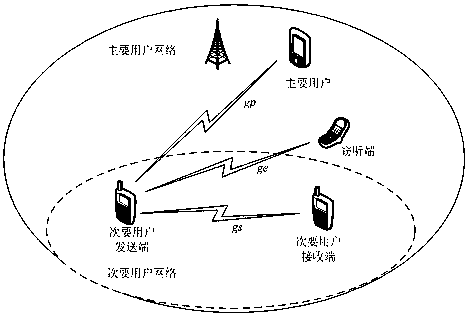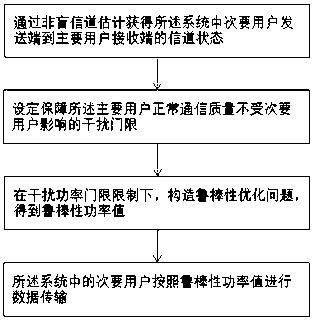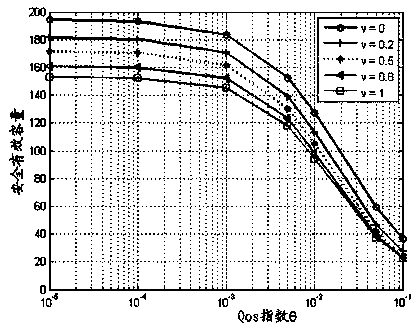Power allocation method in cognitive radio network (CRN) and application thereof in smart transportation network
A distribution method and power technology, applied in power management, wireless communication, electrical components, etc., can solve problems such as not being able to meet the communication needs between vehicle terminals
- Summary
- Abstract
- Description
- Claims
- Application Information
AI Technical Summary
Problems solved by technology
Method used
Image
Examples
Embodiment 1
[0048] refer to figure 1 , the secure cognitive radio network communication model adopted in this embodiment includes four communication nodes: a primary user receiving end, a secondary user transmitting end, a secondary user receiving end, and an eavesdropping end. Under the condition that the interference power to the receiving end of the primary user is lower than the interference temperature, the transmitting end of the secondary user sends a signal to the receiving end of the secondary user. It is assumed that the channel information between secondary users and the channel information between secondary users and eavesdropping users are completely known. During this communication process, the eavesdropping end will eavesdrop on the communication signal, and the secondary user sending end will perform dynamic power allocation according to the change of the channel state and the QoS requirements of the upper-layer user, so that the communication system can be completed under...
Embodiment 2
[0085] This embodiment is based on the cognitive radio network power allocation method provided in Embodiment 1, and proposes a cognitive radio-based intelligent transportation network system. The system detects the idle frequency bands of authorized users and accurately allocates power Unauthorized cognitive users are allowed to use the authorized user's frequency band to communicate when the authorized user does not use the authorized frequency band or does not interfere with the authorized user, thereby effectively alleviating the shortage of spectrum resources in the communication between vehicle terminals.
PUM
 Login to View More
Login to View More Abstract
Description
Claims
Application Information
 Login to View More
Login to View More - R&D
- Intellectual Property
- Life Sciences
- Materials
- Tech Scout
- Unparalleled Data Quality
- Higher Quality Content
- 60% Fewer Hallucinations
Browse by: Latest US Patents, China's latest patents, Technical Efficacy Thesaurus, Application Domain, Technology Topic, Popular Technical Reports.
© 2025 PatSnap. All rights reserved.Legal|Privacy policy|Modern Slavery Act Transparency Statement|Sitemap|About US| Contact US: help@patsnap.com



